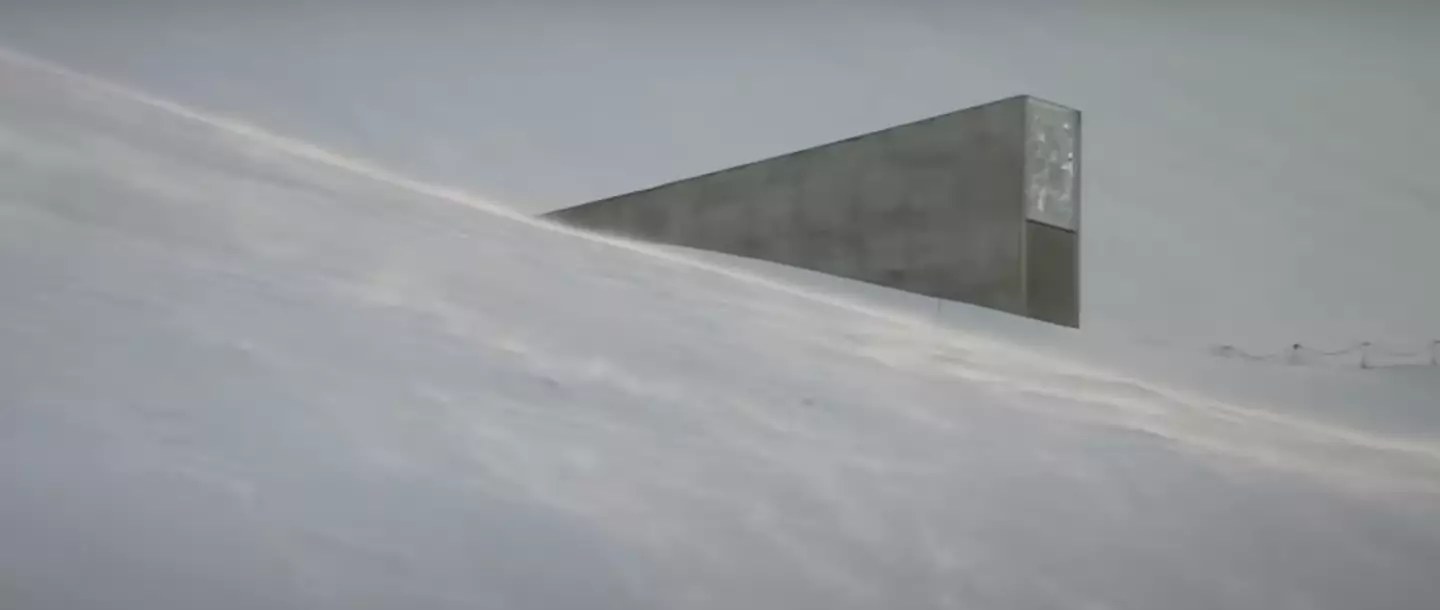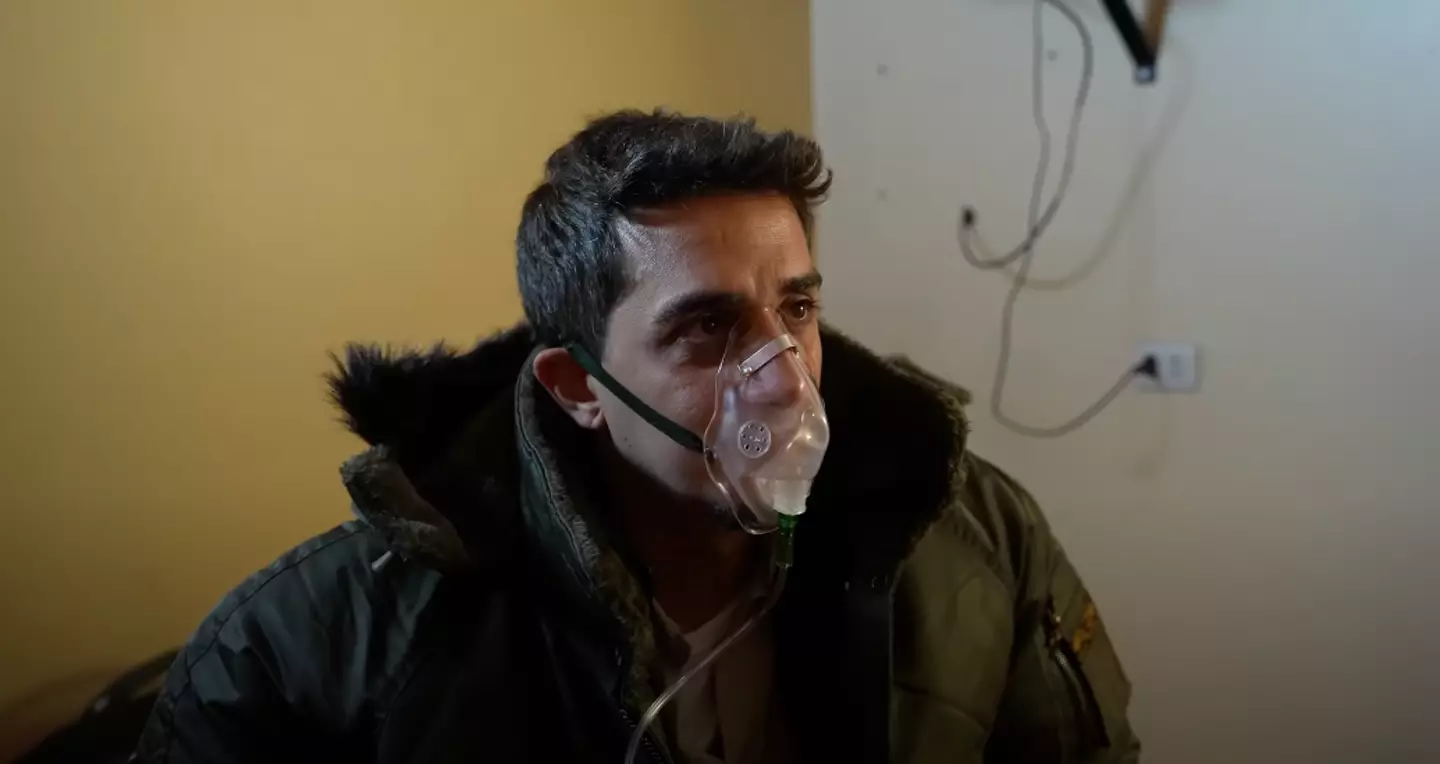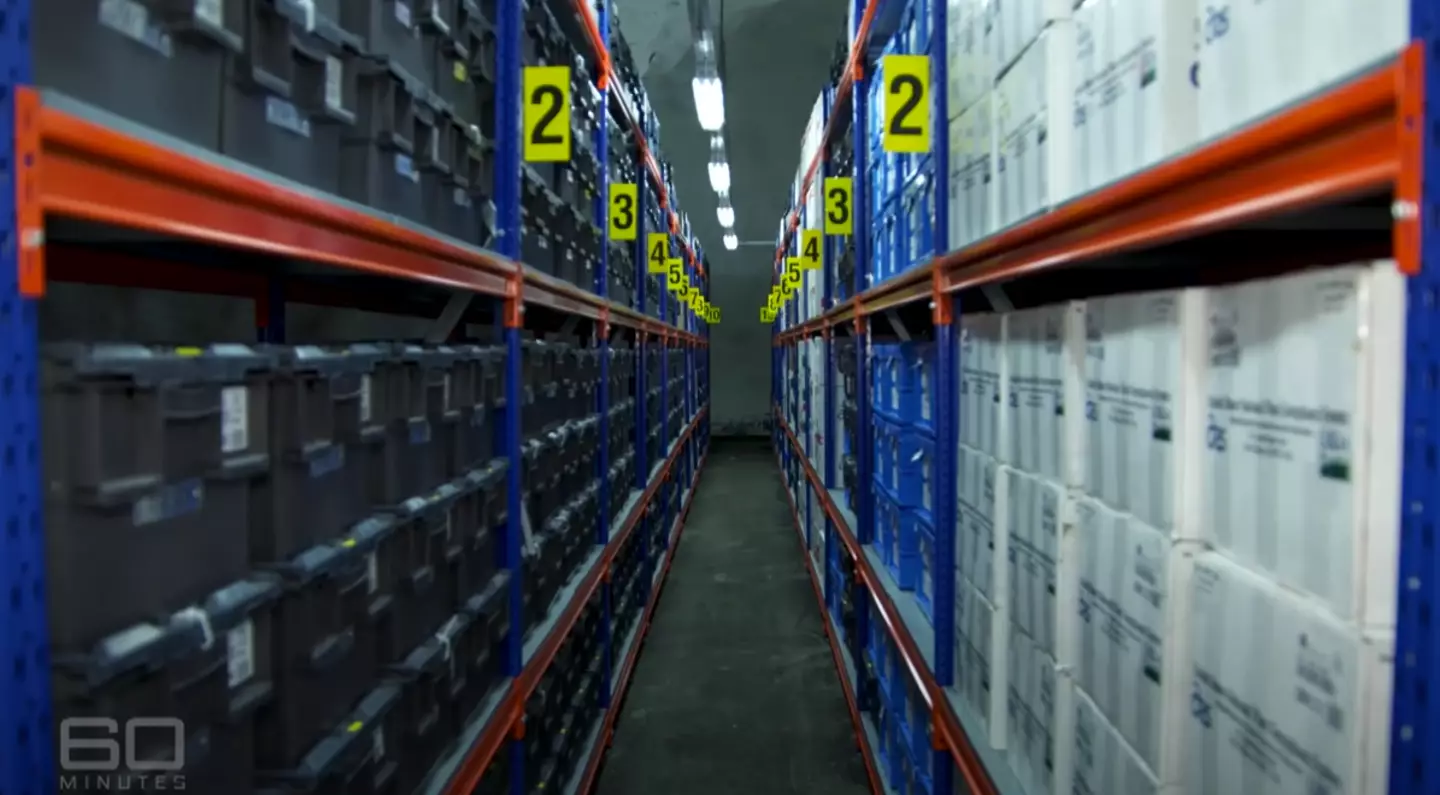
And that’s not forgetting that it’s a pretty isolated spot.

The formal name for this place is the Global Seed Vault, and it’s based in the Svalbard archipelago in Norway.
It was opened in 2008. Well, I say opened – it’s not something the average Joe can waltz in and see, as you might imagine.
As such, the mysterious nature of this place leaves it open to a lot of conspiracy theories.

But the real purpose of this Vault is to store more than one million seed samples in order to prevent crops going extinct. This will prove particularly handy in the event of a war, natural disaster or pandemic.
It’s located deep inside a mountain, with the entrance protruding out from the side. A series of metal detectors block the seeds from the outside world. Its management is a collaboration between the Norwegian government, the Crop Trust and NordGen.
It only opens up six times a year for new seed deposits, but most people never get to see inside this extraordinary place. VICE Impact were lucky enough to get a look inside back in 2020.
Inside, they saw a ‘permafrost’ facility where the seeds were stored in -18C temperatures and the doors were iced over.
Asmund Asdal, a Coordinator at the Vault, said: “I have a quite good feeling when I’m in here and I know that this is a resource that the future will need.”
While you’re out of luck if you want to take a physical tour, a virtual option is available.

It starts you off on the snowy mountainside, before taking you down the long concrete corridor inside. From there, you’re left to wander the ‘Seed Vault Tunnel’.
There are a lot of big echoey rooms inside the place. As small as seeds are, there’s a ton of them so they need the space.
Well, it’s a small comfort to know that even in the event of a nuclear war or global pandemic, we can still have vegetables on our plates.

Whether it’s a beach holiday, or a city break, exploring somewhere new, personally speaking, is one of the most rewarding activities you can do.
But it’s safe to say there is one location that is definitely not on my list and that’s a place which has a life expectancy of just 35.

YouTuber and documentary maker Ruhi Çenet well and truly braved it all after paying a visit to the ‘closest town to space’ where there happens to be 50 percent less oxygen.
Dubbed as the ‘most hellish place on the planet’, La Rinconada, Peru, is the closest inhabited place to the sky on Earth and the content creator thought he would go and see what it was like, so we don’t have to.
Çenet has over eight million subs on YouTube and people keep coming back for more as the avid traveller is known for visiting ‘hard-to-reach places’.
So far he has been to 65 countries across six continents.

After posting his Peru doc on YouTube last December, the video has already racked up over 30 million views.
“La Rinconada, the closest inhabited place to the sky on Earth, where people are living above the clouds,” Çenet explained.
“At this extreme altitude of 5,100 meters, the atmosphere significantly thins and the locals are living with only 50 percent of the usual oxygen levels.
“Their bodies have evolved to produce two times more blood cells than ours.
“On this barren land, not even a single tree can survive because of the low air pressure.
“This town in the Peruvian Andes is even 300 meters higher than Mont Blanc, the highest peak in the Alps of Europe.

“Far from the modern world, it is a place where crime and danger are always nearby.”
Çenet said he felt dizzy as soon as he got out of the cab, and when he woke up in the morning he felt so tired, like he ‘hadn’t rested in days’.
The dry air alone gave him a sore throat along with chapped lips.
Despite it being summer, the roads were icy and smelly, as footage of garbage was visible throughout the city.
He also noticed that people were living in ‘metal shacks’ without electricity, which is very worrying when it gets to as low as -10C in the winter.
The only reason people brave the more-than-difficult conditions is because of mining, Çenet says.
“People come to these harsh lands for only one reason: gold,” he said.
“About 50,000 people have settled here, among piles of trash, all dreaming of wealth.”

Myths about what goes on under the sea still plays on the mind of the more imaginative people, with underwater cities like Atlantis still believed by some to be out there somewhere.
However, scientists have recently stumbled upon a ‘lost city’ in the Atlantic Ocean that is actually home to several sea animals and probably has its own Sebastian Crab – somewhere.

A lost underwater city has been discovered (Open Ocean Exploration)
This Lost City consists of some rocky, towering structures that are just west of the Mid-Atlantic Ridge mountain range – which runs along the middle of the Atlantic ocean, separating the North American plate from the Eurasian Plate and the African Plate.
There are huge walls in the city, as well as columns and even monoliths, with some over 60 metres tall.
Sadly fantasy fans, it isn’t the site of an ancient human civilisation that was covered by a rising sea level, but its discovery is still noteworthy in the world of science.
It’s actually been named the ‘Lost City’ following its discovery back in 2000, and according to Science Alert, it is the longest living venting environment in the ocean, to our knowledge.

The environment was only discovered 24 years ago (Open Ocean Exploration)
There is nothing else like it on our planet, as it’s believed that it could give us an insight into other ecosystems that exist on other planets in the universe.
Snails and microbial communities have survived here by feeding off the field’s vents, which let out hydrogen, methane and other various gases into the water.
Oxygen is absent here, but larger animals can also survive in the Lost City, with the likes of crabs (I told you Sebastian was here), eels and shrimps, though they are harder to find.
Unlike other places, hydrocarbons produced here are not created by sunlight, sitting 750-900 metres below the water and therefore being on the verge of the ‘midnight zone’, where no light reaches (at around 1,000 metres).
Instead, it relies on chemical reactions that happen on the seabed, while this could give us an insight to how life on our planet originated 3.7 billion years ago as well.

It can be found along the bottom of the Atlantic Ocean (Open Ocean Exploration)
Microbiologist William Brazelton claimed to The Smithsonian back in 2018: “This is an example of a type of ecosystem that could be active on Enceladus or Europa (moons of Saturn and Jupiter) right this second. And maybe Mars in the past.”
In honour of Greek mythology, the tallest monolith in the Lost City has been named Poseidon, after the Greek God of the sea.
There have been calls to make the Lost City a World Heritage site to protect the rare site, as humans can’t help themselves to destroying the environment, but it may be too late.
Poland won the rights to mind the deep sea around the area back in 2018, but though they are not allowed to touch the Lost City, changing its surroundings could have dire consequences.
Formally known as The Global Seed Vault, the facility in the Svalbard archipelago, Norway, stores seeds from around the world while also protecting our future food supply.
Opened back in 2008, the Vault is closed to the public and understandably, surrounded by mystery – there’s plenty of doomsday conspiracy theories out there, hence the name.
But in reality, The Global Seed Vault houses over one million seed samples to prevent the loss of crop species after the likes of a war, natural disaster or pandemic.
.jpg)
Martin Zwick/REDA&CO/Universal Images Group via Getty Images)
And it does look pretty mysterious to be fair, as it’s located deep inside a mountain, with the entrance sticking out before a series of metal doors hide away the samples.
It’s built to last forever and is co-managed by the Norwegian government, the Crop Trust and NordGen.
But as it’s closed off to the public and only opens up to six times a year to take in new deposits from global seed banks, people don’t typically get a look at what it’s like in the ‘Doomsday Vault’.
So, back in 2020, VICE Impact released a video with Motherboard, heading ‘deep inside the mountain’ to the vault.

HAKON MOSVOLD LARSEN/SCANPIX NORWAY/AFP via Getty Images
The crews saw the ‘permafrost’ facility where temperatures are kept at -18C and doors are iced over.
Asmund Asdal, a Coordinator at the Vault, took the team into the ‘world’s most important room’.
Here, ‘seeds from all countries in the world’ are kept in shelves and shelves of boxes.
Asdal explained how when the ‘gene bank’ in Aleppo, Syria, was destroyed, they were able to send seeds back out to them.
“If they had no backup here the seeds would have gone extinct,” he said.

60 Minutes Australia
Showing the huge number of samples, Asdal added: “I have a quite good feeling when I’m in here and I know that this is a resource that the future will need.”
And while you might never find yourself stepping foot into the ‘Doomsday Vault’, you can actually take a virtual tour.
Starting off on the snowy mountain, you walk along the long, long concrete corridor before wandering the ‘Seed Vault Tunnel’. It really does look like something out of a sci-fi flick.
It’s a lot of big empty, echoey rooms, with one known as the ‘Cathedral’.
The tour allows you to ‘explore the collection’ and wander aisles of the seed chambers.
Well, at least we know we’ll never run out of plants.
While scientists have never been able to verify the legendary sunken city of Atlantis, it appears they’ve at least succeeded in discovering one ancient underwater landscape.
14 years ago, experts sent rovers to investigate what they believed was a towering, rocky landscape.
This field is situated west of the Mid-Atlantic Ridge and is thought to be the longest-lived venting environment known in the ocean, reports Science Alert.
Attributes of the underwater area include ancient walls thought to be at least 120,000 years old; chimneys spewing 104 Fahrenheit gasses and a monolith, named after Poseidon, the Greek god of the sea.
Despite the harsh conditions, the Lost City plays host to an abundance of ocean-dwelling creatures.
These include snails, microbial communities and various crustaceans.
It’s thought that these beasts feed off the field’s vents, which reportedly spit out hydrogen, methane and other gasses.
.jpg)
Various chimneys were discovered at the Lost City. (University of Washington/Woods Hole Oceanographic Institution)
Moreover, microbiologists also claim that animals such as crabs, shrimps and eels also inhabit the environment.
However, as there is a distinct lack of oxygen present in the Lost City, these aquatic beats are a rare find.
Scientists say that hydrothermal fields, like the one they found in the Atlantic Ocean, probably exist elsewhere.
However, the outlined find remains the only one, which remotely operated vehicles have been able to navigate to thus far.
Speaking about the ancient ecosystem, microbiologist William Brazelton told The Smithsonian in 2018: “This is an example of a type of ecosystem that could be active on Enceladus [Saturn’s moon] or Europa [Jupiter’s moon] right this second and maybe Mars in the past.”
Since its discovery in 2000, there have been numerous calls to protect the site due to its importance.

Scientists have called to protect the site from mining damage. (University of Washington/Woods Hole Oceanographic Institution)
However, in 2018, Poland was given the right to explore 10,000 sq km of the Mid-Atlantic Ridge for mining.
It’s thought the seabed initially garnered attraction due to it being rich in deposits of cobalt, manganese and gold, according to The Independent.
Speaking about the decision, Dr Gretchen Fruh-Green, the scientist who led the discovery said that explorers run the risk of ‘destroying’ the Lost City.
“We could destroy this place before we’ve understood it – before we can really appreciate the significance of these unique white towers and these very strange fluids that are coming out of the ocean floor,” she told Sky News.
“The significance of that for understanding the origin of life, for understanding processes in early Earth.
“It’s our history, it’s the Earth’s history, and if we perturb it we don’t know how fast it will recover, or what influence the perturbation would have on ocean chemistry.”




